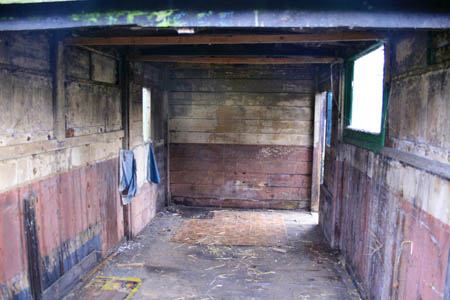This vehicle, still retaining its timber underframe (albeit rather rotten in parts), arrived on the Bluebell on 5th November. Brought to our attention by Bluebell fireman Clive Williams, there followed a couple of years' research and patient negotiation by David Wigley and Tony Clements. With thanks to the Bluebell Railway Trust for funding the transport and paying a share of the cost of a replacement garage, the Bluebell now has plugged that long-felt gap in our rolling stock collection.
It has been covered with a tarpaulin, since overhaul will not be starting for a little while. The body (of teak and red cedar) is in relatively good condition, and remarkably complete, with just one end and the internal partition (separating the groom's compartment from the horses) missing, along with the dog/fodder box which also formed the groom's seat.
 Photo right: The interior of the horsebox, as recovered. (Dave Clarke)
Photo right: The interior of the horsebox, as recovered. (Dave Clarke)
LCDR Horsebox No.1 was completed on 12 June 1882, at the LCDR's Longhedge Works. The design (to which 35 were built) dated from 1872. No.1 was renumbered 1002 on 27 July 1898 under the '1897' LCDR renumbering scheme, and later became SECR No.184.
It was condemned in 1922 and became a yard checker's hut at Hythe station.
In 1923, it was apparently sold to a Mr Sinclair, as one of nine that he bought, most being moved to Dungeness. Some of the others remained, discarded and derelict at Dungeness for many years, but this one stayed at Hythe station yard, from where it was purchased in 1937 by Mr Howland for 7s 6d (37 1/2p). It was transported by lorry to No 1 Tanners Hill Gardens, Hythe, where it was slid off onto a concrete base.
During the Second World War there was an anti-aircraft battery set up on allotments behind the house, and Mr Howland let the gunners sleep in the horsebox. The end was cut out of the vehicle at some stage to make a garage, for what must have been a small car such as an Austin 7 or Ruby.
Whilst Gatwick Plant Hire, assisted by a small Bluebell team, were removing the horsebox, a car rolled up with an old gentleman in it. Assuming he wanted to drive down to the end of the lane we went to explain that we were going to be a rather long time! He in turn explained that he was Ray Howland (the son of the original owner), had watched it arrive in 1937 and had come to see it go again!
It was Ray's sister who, in 1930, had planted the walnut tree that was currently causing us some grief in trying to remove the horsebox (since the present owner was keen that we should not damage the tree!).
At the end of a long day the horsebox finally arrived at Horsted and was placed on the redundant 'Tube' wagon underframe. Some areas inside the horsebox (in the groom's area and also the cant-rail and inner roof of the main part) show signs of scumbling (painted to simulate wood-grain) under a later (presumably SECR) coat of "stone" above the waist and "smudge" below. Outside under a black domestic finish are signs of an odd shade of green which we have also found on other bodies sold around this time - perhaps Ashford just tarted them up for onward sale? On the solebar is a very faint stencilled date 6/82 - confirming the build date!
POSTSCRIPT
Regrettably, the timberwork of this horsebox body was completely destroyed in an accidental fire at Horsted Keynes in the early hours of 16 July 2010. The fire appears to have been caused by sparks whipped up by extremely strong winds, from the embers of a bonfire which had been burning 20-30 feet away a day or two earlier. The feasibility of reconstructing it from the salvaged remains are being considered.
Type: Horsebox with groom's compartment - later SECR Class D
Built: 30 June 1882, at Longhedge Works (LCDR)
Original No: 1
Subsequent Nos: 1002 (27 July 1898) and SECR 184
Length: 14' 1" over body, Width: 8' 1"
Weight: 6 Tons 13 Cwt
Brakes: Westinghouse (air) braked from new. Vacuum pipe (only) added, 1 March 1901
Heating: Steam heat pipe (only) fitted, 14 August 1919
Withdrawn: 30 November 1922
Sold by SR: 1937
To Bluebell: 5 November 2007
Owner: Bluebell Railway Trust
Timbers destroyed: in an accidental fire, 16 July 2010
Details of the original recovery and further photos of the interior are available thanks to Dave Clarke. This album also shows what remained after the fire.











